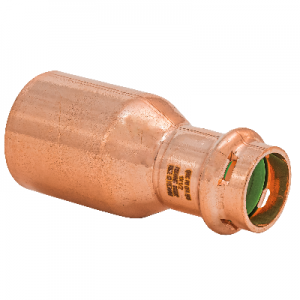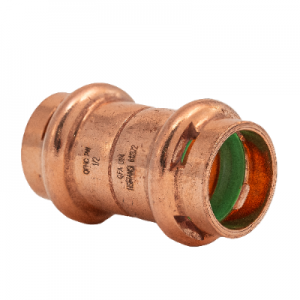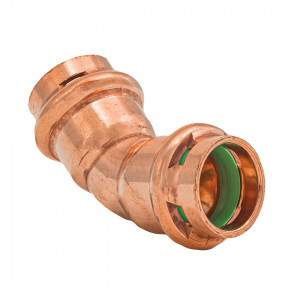
SurePress® is an innovative line of press fittings that visually confirms a pressed connection. Green indication fills windows once pressed, confirming a successful seal. This allows installers and inspectors to quickly identify if a fitting has been pressed prior to pressure testing. Simply press the fitting, see green and go!
• Fluids/Water
• Hot and cold potable water
• Rainwater/Gray water
• Chilled water
• Residential steam (5 psi maximum)
 Copper Press Reducer Fittings
Copper Press Reducer Fittings  Brass 90 Degree Drop Ear Elbow
Brass 90 Degree Drop Ear ElbowIt’s a shut-off valve that has press connections on both ends for joining to copper pipe. A SurePress ball valve allows you to install a control valve (for water or hydronic lines) by pressing it onto the pipes rather than sweating (soldering) or threading it. Inside, it’s a typical ball valve mechanism – a quarter-turn handle that opens or closes flow through a drilled ball. The advantage is in the installation: with press ends, you can quickly connect the valve into a line with no welding and minimal downtime.
First, ensure the valve is in the open position (this is a good practice to avoid trapping air or accidentally pressing on a closed valve). Then insert the copper pipes into each press end of the valve fully. It helps to mark the insertion depth on the pipe to verify it’s fully seated. Position your press tool over one end of the valve and crimp it – the tool will compress the fitting’s collar around the pipe, sealing the O-ring. Do the same on the other end of the valve. Be careful to place the tool only on the intended press collar (avoid pressing on the valve body). Once both ends are pressed, the ball valve is installed. You can immediately turn the valve on or off and even pressurize the system – there’s no wait time as there would be for solder cooling.
Yes, SurePress ball valves are full-port (full-bore), meaning the internal ball opening is as large as the pipe diameter. This ensures you don’t lose flow or pressure through the valve – it performs just like a standard soldered full-port valve. Additionally, the valve is made from lead-free brass, so it’s safe for potable water systems and meets lead-free plumbing codes. The seals and seats inside are typically PTFE and EPDM, designed for longevity. In short, you’re getting a valve that has the same flow capacity and safety compliance as any traditional brass ball valve, just with press connections for convenience.
The benefits are significant for installers:
SurePress ball valves also incorporate the visual press indicator on each end, so you can visually confirm both ends have been properly crimped before restoring pressure. All these advantages translate to time saved and a more reliable outcome (fewer callbacks) for the contractor. In terms of performance, you still get a durable valve with a lifetime comparable to any high-quality brass ball valve.

